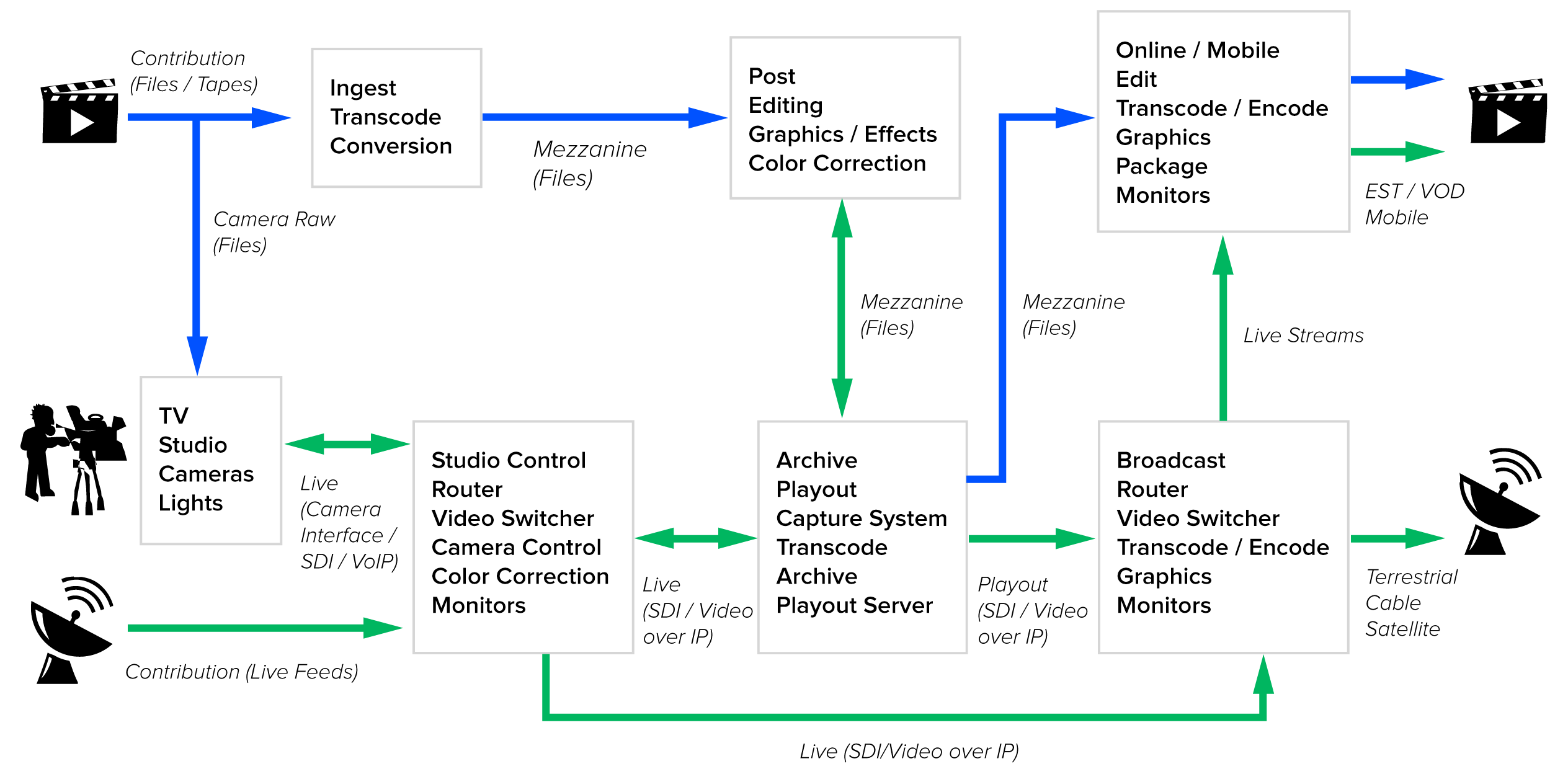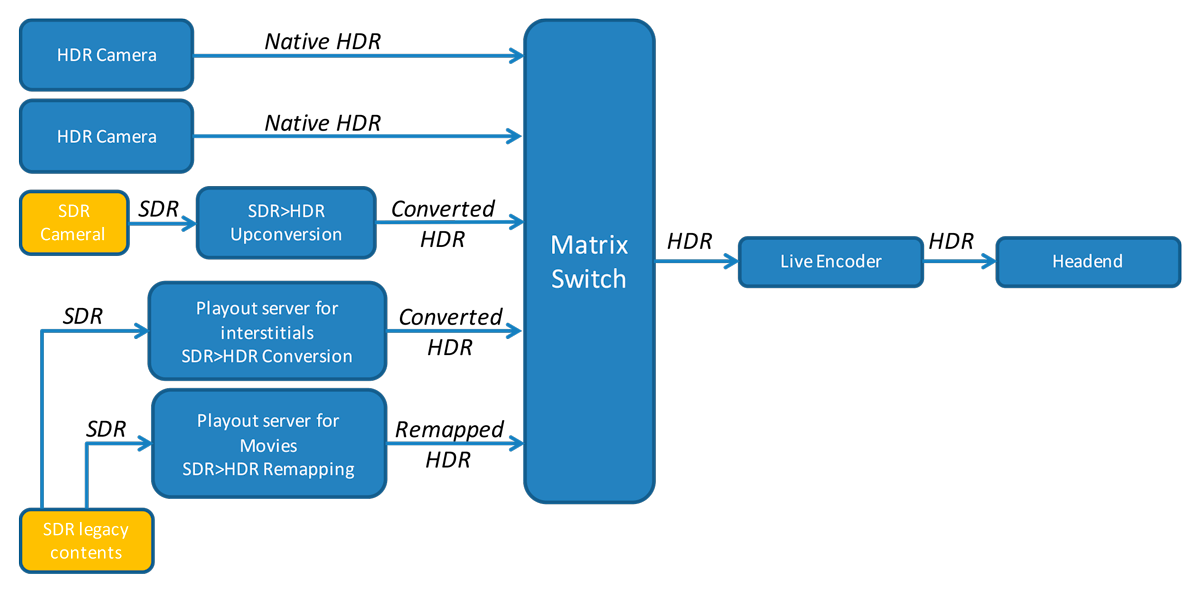Updated to v1.5 September 2018
You can download release 1.5 of phase A Guidelines from this link: Ultra-HD-Forum-Guidelines-Phase-A-v1.5-final
Introduction
This summary document provides an overview of the Ultra HD Forum Guidelines document is viewable at the bottom of this page with a download link at the very end.
The initial focus of the Guidelines is on technologies and practices that support a commercially deployable Ultra HD real-time linear service with live and pre-recorded content in 2016, which is termed a “UHD Phase A” service.
The topics covered in the Guidelines document are evolving rapidly, and as such this is a living document. The Ultra HD Forum will continue to update the document to reflect emerging technology and standards (e.g., MPEG, ITU-R, DVB, ATSC, SMPTE, SCTE, ARIB, SARFT, etc.) as well as best practices collected by Forum members’ experiences and Forum Plugfest events.
Below is a summary of topics included in the Guidelines document.
UHD Phase A Definition
The Ultra HD Forum considered the below key parameters for UHD Phase A services. The Guidelines document includes use cases supporting the different possible UHD Phase A configurations.
| Spatial Resolution | 1080p* or 2160p |
| Color Gamut | BT.709, BT.2020 |
| Bit Depth | 10-bit |
| Dynamic Range | SDR, PQ, HLG |
| Frame Rate** | 24, 25, 30, 50, 60 |
| Video Codec | HEVC, Main 10, Level 5.1 |
| Audio Channels | Stereo or 5.1 or channel-based immersive audio |
| Audio Codec | AC-3, EAC-3, HE-ACC, AAC-LC |
| Broadcast security | AES or DVB-CSA3, using a minimum of 128 bits key size |
| IPTV / OTT security | AES as defined by DVB |
| Transmission | Broadcast (TS), Multicast (IP), Unicast Live & On demand (DASH ISO BMFF) |
| Captions/Subtitles Coding (in/out formats) | CTA-608/708, ETSI 300 743, ETSI 300 472, SCTE-27, IMSC1 |
*1080p together with WCG and HDR fulfills certain use cases for UHD Phase A services and is therefore considered to be an Ultra HD format for the purposes of this document. 1080p without WCG or HDR is considered to be an HD format. The possibility of 1080i or 720p plus HDR and WCG are not considered here. HDR and WCG for multiscreen resolutions may be considered in the future.**Fractional frame rates for 24, 30 and 60 fps are included, but not preferred. Lower frame rates may be best applied to cinematic content. |
|
Production
The guidelines document addresses both Pre-recorded and Live content production. Below is a generic diagram of a production system whose functions are documented in the guidelines.
Use of mixed HDR and SDR source content in a live production is considered, e.g., live HDR camera footage overlaid with SDR graphics, as shown in the below diagram.
HDR and WCG
A number of HDR/WCG technologies are discussed, including pros and cons of each according to various use cases. In addition to already existing terms such as HLG, PQ or HDR10, the Ultra HD Forum has defined terms that apply to near-term deployments of HDR/WCG services. Phase A HDR/WCG technologies include:
- HDR10 (CTA definition)
- PQ (SMPTE ST 2084 definition)
- PQ10 (Ultra HD Forum definition: PQ EOTF plus BT.2020 color space and 10-bit depth)
- HLG (Rec. BT.2100 definition)
- HLG10 (Ultra HD Forum definition: HLG OETF plus BT.2020 color space and 10-bit depth)
Conversion Between SDR and HDR and Between HDR Technologies
The Guidelines describes mechanisms used to convert or map between SDR and HDR and between HDR technologies. Use cases are offered to suggest where in the distribution chain such conversions are recommended and which conversion method to choose for a given situation. Management of peak brightness across the production chain is also documented.
Signalling and Metadata Carriage
Carriage of metadata for HDR10 and signaling transfer function and color space are discussed, including work-arounds in cases where standards and processes do not yet exist in the workflow. For example, methods of compensating for the lack of HDR metadata carriage over SDI are offered. The Guidelines will be updated as these and other “roadblocks” are removed through work in SDOs and other organizations.
Distribution Chain
The Guidelines document covers the end-to-end workflow for constructing a real-time linear service comprised of live and/or pre-recorded content – aka “glass to glass” – and delivering it from production to the consumer. Separate sections are dedicated to each step in the chain, and each section includes compression technologies, metadata carriage options, sample bitrate ranges, audio, captions/subtitles, etc. Consideration is given to content manipulation that may occur at each point in the chain, such as ad insertion, graphic overlay, “squeeze & tease” and similar operations. Tables describing bitrate ranges and key parameters as well as flow diagrams are provided for each step, including a sample bitrates for ABR services.
Security
Security requirements are evolving and solutions need to stay ahead of piracy techniques. The Guidelines document contains recommendations for a secure system in 2016, including watermarking, key size and encryption technologies.
Decoding & Rendering
The Guidelines documents decoding and rendering devices in the consumer home. It covers the key parameters that devices need in order to process UHD Phase A content including carriage of data over common interfaces such as HDMI. For example, certain Ultra HD parameters are not carried over HDMI 2.0a; the document offers insight into the timeline of standards development and equipment upgrade possibilities. This section also touches on considerations for displaying closed captions or graphic overlays on the consumer device.
Backward Compatibility
Some services may have a requirement that a delivered UHD Phase A stream be able to serve legacy displays that are able to render 2160p/SDR content. To add complexity, some such displays may be capable of processing BT.2020 while others may be restricted to BT.709. There are multiple ways to provide backward compatibility depending on the type of service provider and the parameters of the UHD Phase A content. For example, HLG10 is designed to provide a degree of backward compatibility with an SDR TV set that supports the colorimetry of the delivered signal, i.e., BT.2020. When using PQ10 or HDR10 (or HLG10 in the case of a BT.709 TV), inherent backward compatibility is not expected, thus a down-conversion step must be taken at some point in the supply chain. Several possible methods for serving legacy consumer devices are described in the Guidelines document. Note that the Ultra HD Forum does not offer guidance about the quality of an SDR/BT.2020 rendering of an HLG10 signal, nor the quality of various down-conversion methodologies; service providers are advised to evaluate the possibilities for satisfactory quality, as well as check the best solution that fits the installed base of receivers (STBs & TVs).
Key updates in December 2016 (version 1.2)
- Implementation of channel-based immersive audio for Phase A (e.g., Dolby Atmos)
- ETSI TS 103 433 method for down-converting HDR/WCG to SDR/BT.709
- Carriage of signalling for transfer function, color container and color matrix, including newly added information for file-based video formats
- A brief summary/comparison of ITU-R BT.709, BT.2020 and BT.2100
- ACES Workflow for color and dynamic range
- Dynamic HDR metadata technologies as candidates for the forum’s future work in Phase B
Key update in April 2017 (version 1.3)
- inclusion of Forensic Watermarking guidelines.
- The Ultra HD Forum is continuing to refine and update this document as new information regarding Phase A UHD services emerges. For example, recent industry discussions about the definitions of PQ10 and HDR10 are actively being considered in the Guidelines Work Group.
Key Updates in September 2017 (V1.4):
- Clarified definitions of PQ10 and HDR10 (Sections 3, 6.1.1 and 6.1.5)
- Added a table showing a matrix of 14 different receiver/decoder capability combinations, and a table of 12 different service formats which indicates which of the receiver/decoders can render which service formats (Tables 4 and 5)
- Added text about using statistical methods of deriving CLL values, thanks to input from UHDA (Section 6.1.4)
- Added “graphics white” level for HLG as recommended by BBC and NHK (Section 6.1.10)
- Added a cautionary statement about including PQ-related metadata in an HLG stream, thanks to information learned in UHDF InterOps (Section 8.3)
- Added a table of “real world” bitrates as reported by UHDF service provider members (Section 9.3.2)
- Added an annex on HDR dynamic metadata (Annex G)
- Various minor updates, e.g., updated references, etc.
Key updates in September 2018 (V1.5)
- Descriptions and workflow diagrams of four “real world” deployments of UHD / HDR services for marquee television events (major sports tournaments, parades, etc.).
- Synergies between Phase A and Phase B technologies. (Phase B technologies are independent, incremental additions to the foundation of Phase A technologies.)
- Important new standards that support Phase A workflows, including SMPTE ST 2108-1 for carriage of HDR metadata over SDI interfaces.
- Clarification between “HDR10” and “PQ10” to ensure alignment with other new SDOs’ specifications such as SCTE’s.
- More detail about two-step forensic watermarking methods.


